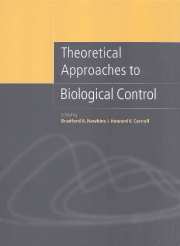Part III - Spatial considerations
Published online by Cambridge University Press: 13 August 2009
Summary
The ability of spatial structure to stabilize predator–prey interactions was demonstrated in Huffaker's classic mite–mite–orange experiment 40 years ago. Yet, atypically theory lagged behind the empirical data, and it was not until the 1970s that spatially explicit models began to appear, and only more recently have they been applied to biological control problems. Although the issue of spatial structure arises in other sections of this book, this section comprises three chapters whose primary focus is on the role of space on population dynamics, enemy–victim interactions, and biological control.
It is not surprising that an understanding of spatial phenomena is most developed for mite biological control; mites were Huffaker's original subjects, they are small enough to maintain numerous populations on a desk-top, and they mostly disperse by walking. In Chapter 10, Walde & Nachman review the use of spatially explicit models to explain and improve the control of spider mites. They emphasize the integration of theoretical predictions and experimental data on mite populations in greenhouses and apple orchards. These two systems represent fundamentally different environmental situations, yet they share enough attributes that the same conceptual tools apply to both. The key to success in spatially structured pest systems is dispersal, and biological control workers have long appreciated its importance. However, the developing theory allows this complex variable to be dissected into its components to identify which are most important to pest control.
- Type
- Chapter
- Information
- Theoretical Approaches to Biological Control , pp. 161 - 162Publisher: Cambridge University PressPrint publication year: 1999



